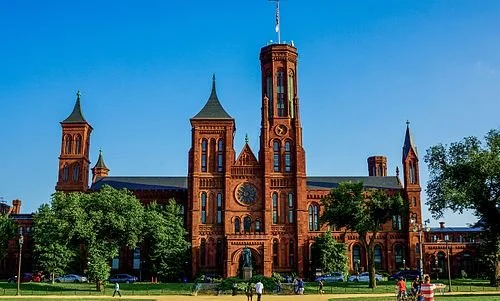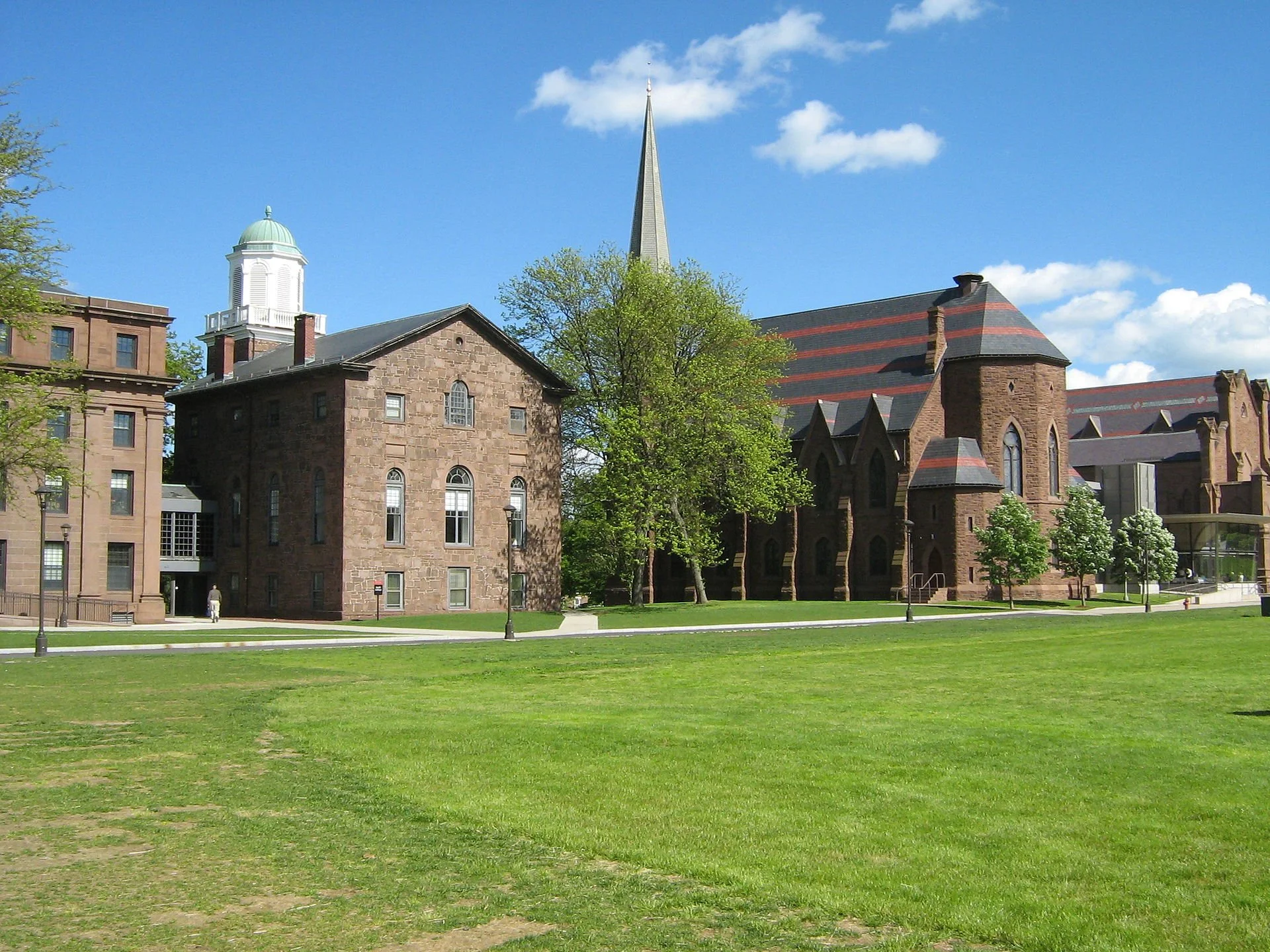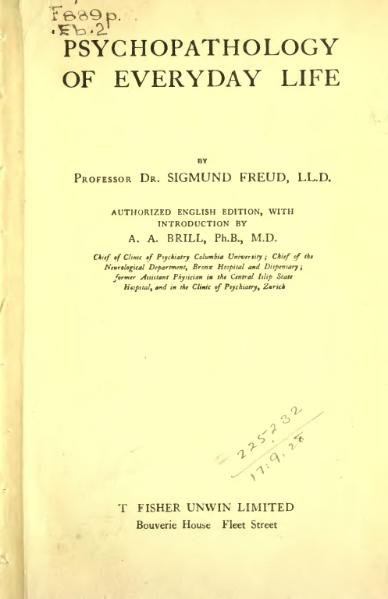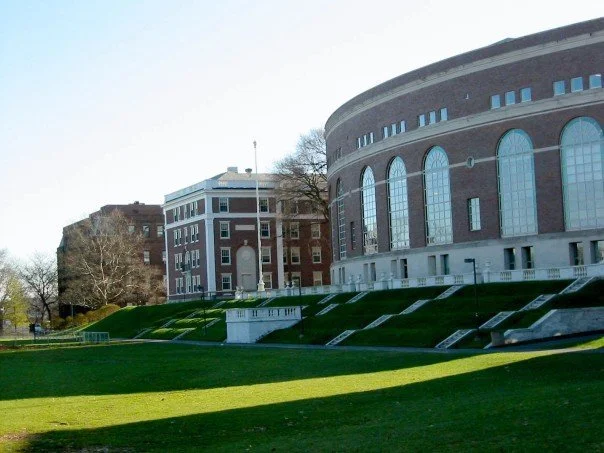
Jennifer Tucker: Trump opens new front in culture wars
The Smithsonian Building (aka “The Castle”), in Washington.
Jennifer Tucker is a professor of history at Wesleyan University.
She does not work for, consult, own shares in or receive funding from any company or organization that would benefit from this article, and has disclosed no relevant affiliations beyond their academic appointment.
This article, except for the picture above, is from The Conversation.
MIDDLETOWN, Conn.
I teach history in Connecticut, but I grew up in Oklahoma and Kansas, where my interest in the subject was sparked by visits to local museums.
I fondly remember trips to the Fellow-Reeves Museum, in Wichita, Kansas, and the National Cowboy & Western Heritage Museum in Oklahoma City. A 1908 photograph of my great-grandparents picking cotton has been used as a poster by the Oklahoma Historical Society.
This love of learning history continued into my years as a graduate student of history, when I would spend hours at the Smithsonian Institution’s National Air and Space Museum learning about the history of human flight and ballooning. As a professor, I’ve integrated the institution’s exhibits into my history courses.
The Trump administration, however, is not happy with the way the Smithsonian Institution and other U.S. museums are portraying history.
On March 27, 2025, the president issued an executive order, “Restoring Truth and Sanity to American History,” which asserted, “Over the past decade, Americans have witnessed a concerted and widespread effort to rewrite our Nation’s history, replacing objective facts with a distorted narrative driven by ideology rather than truth. Under this historical revision, our Nation’s unparalleled legacy of advancing liberty, individual rights, and human happiness is reconstructed as inherently racist, sexist, oppressive, or otherwise irredeemably flawed.”
Trump singled out a few museums, including the Smithsonian, dedicating a whole section of the order on “saving” the institution from “divisive, race-centered ideology.”
Of course, history is contested. There will always be a variety of views about what should be included and excluded from America’s story. For example, in my own research, I found that Prohibition-era school boards in the 1920s argued over whether it was appropriate for history textbooks to include pictures of soldiers drinking to illustrate the 1791 Whiskey Rebellion.
But most recent debates center on how much attention should be given to the history of the nation’s accomplishments over its darker chapters. The Smithsonian, as a national institution that receives most of its funds from the federal government, has sometimes found itself in the crosshairs.
America’s historical repository
The Smithsonian Institution was founded in 1846 thanks to its namesake, British chemist James Smithson.
Smithson willed his estate to his nephew and stated that if his nephew died without an heir, the money – roughly US$15 million in today’s dollars – would be donated to the U.S. to found “an establishment for the increase and diffusion of knowledge.”
The idea of a national institution dedicated to history, science and learning was contentious from the start.
In her book The Stranger and the Statesman, historian Nina Burleigh shows how Smithson’s bequest was nearly lost due to battles between competing interests.
Southern plantation owners and western frontiersmen, including President Andrew Jackson, saw the establishment of a national museum as an unnecessary assertion of federal power. They also challenged the very idea of accepting a gift from a non-American and thought that it was beneath the dignity of the government to confer immortality on someone simply because of a large donation.
In the end, a group led by congressman and former president John Quincy Adams ensured Smithson’s vision was realized. Adams felt that the country was failing to live up to its early promise. He thought a national museum was an important way to burnish the ideals of the young republic and educate the public.
Today the Smithsonian runs 14 education and research centers, the National Zoo and 21 museums, including the National Portrait Gallery and the National Museum of African American History and Culture, which was created with bipartisan support during President George W. Bush’s administration.
In the introduction to his book Smithsonian’s History of America in 101 Objects, cultural anthropologist Richard Kurin talks about how the institution has also supported hundreds of small and large institutions outside of the nation’s capital.
In 2024, the Smithsonian sent over 2 million artifacts on loan to museums in 52 U.S. states and territories and 33 foreign countries. It also partners with over 200 affiliate museums. YouGov has periodically tracked Americans’ approval of the Smithsonian, which has held steady at roughly 68% approval and 2% disapproval since 2020.
Smithsonian in the crosshairs
Precursors to the Trump administration’s efforts to reshape the Smithsonian took place in the 1990s.
In 1991, the Smithsonian American Art Museum, which was then known as the National Museum of American Art, created an exhibition titled “The West as America, Reinterpreting Images of the Frontier, 1820-1920.” Conservatives complained that the museum portrayed western expansion as a tale of conquest and destruction, rather than one of progress and nation-building. The Wall Street Journal editorialized that the exhibit represented “an entirely hostile ideological assault on the nation’s founding and history.”
The exhibition proved popular: Attendance to the National Museum of American Art was 60% higher than it had been during the same period the year prior. But the debate raised questions about whether public museums were able to express ideas that are critical of the U.S. without risk of censorship.
In 1994, controversy again erupted, this time at the National Air and Space Museum over a forthcoming exhibition centered on the Enola Gay, the plane that dropped the first atomic bomb on Hiroshima 50 years prior.
Should the exhibition explore the loss of Japanese lives? Or emphasize the U.S. war victory?
Veterans groups insisted that the atomic bomb ended the war and saved 1 million American lives, and demanded the removal of photographs of the destruction and a melted Japanese school lunch box from the exhibit.
Meanwhile, other activists protested the exhibition by arguing that a symbol of human destruction shouldn’t be commemorated at an institution that’s supposed to celebrate human achievement.
Republicans won the House in 1994 and threatened cuts to the Smithsonian’s budget over the Enola Gay exhibition, compelling curators to walk a tightrope. In the end, the fuselage of the Enola Gay was displayed in the Smithsonian’s National Air and Space Museum. But the exhibit would not tell the full story of the plane’s role in the war from a myriad of perspectives.
Trump enters the fray
In 2019, The New York Times launched the 1619 project, which aimed to reframe the country’s history by placing slavery and its consequences at its very center. The first Trump administration quickly responded by forming its 1776 commission. In January 2021, it produced a report critiquing the 1619 project, claiming that an emphasis on the country’s history of racism and slavery was counterproductive to promoting “patriotic education.”
That same year, Trump pledged to build “a vast outdoor park that will feature the statues of the greatest Americans to ever live,” with 250 statues to mark the 250th anniversary of the Declaration of Independence.
President Joe Biden rescinded the order in 2021. Trump reissued it after retaking the White House, and pointed to figures he’d like to see included, such as Christopher Columbus, George Washington, Betsy Ross, Sitting Bull, Bob Hope, Thurgood Marshall and Whitney Houston.
I don’t think there is anything wrong with honoring Americans, though I think a focus on celebrities and major figures clouds the fascinating histories of ordinary Americans. I also find it troubling that there seems to be such a concerted effort to so forcefully shape the teaching and understanding of history via threats and bullying. Yale historian Jason Stanley has written about how aspiring authoritarian governments seek to control historical narratives and discourage an exploration of the complexities of the past.
Historical scholarship requires an openness to debate and a willingness to embrace new findings and perspectives. It also involves the humility to accept that no one – least of all the government – has a monopoly on the truth.
In his executive order, Trump noted that “Museums in our Nation’s capital should be places where individuals go to learn.” I share that view. Doing so, however, means not dismantling history, but instead complicating the story – in all its messy glory.
The Conversation U.S. receives funding from the Smithsonian Institution.
Chris Powell: Has abortion really become state’s highest social good? the phony U.S. debt-ceiling crisis
The rear of College Row at Wesleyan University in Middletown, Conn. From left to right: North College, South College, Memorial Chapel, Patricelli '92 Theater
— Photo by Smartalic34
MANCHESTER, Conn.
Maybe nothing less could have been expected from Wesleyan University in Middletown, Conn., a citadel of leftist groupthink, but according to the university chapter of the Democratic Socialists, the university has agreed to pay for abortions for its students. Not for treatment of cancer or multiple sclerosis or Crohn’s disease or AIDS or other serious ailments, just abortions.
The university’s implication is that while those ailments are often fatal, abortion is the highest social good.
Wesleyan’s decision rhymes with the clamor at the state Capitol, where proclamations of fidelity to abortion rights trump the daily shootings in the cities, the repeat offenders running rampant, the collapse of public education, the worsening poverty, and the government’s shift away from public service to a mere pension and benefit society.
The people who extol abortion well may believe that it is the highest social good. Yet their clamor seems a bit out of place in Connecticut, where a Roe v. Wade policy on abortion was enacted years ago and will remain in force whatever other states do with their new freedom to legislate on the issue. In Connecticut, abortion anywhere, any time is challenged only by occasional calls for requiring parental notification for abortion for minors. While parental notification has broad support with the public, nothing can sway the abortion fanatics in control of the General Assembly’s Democratic caucus.
So abortion fanaticism may be meant mainly as a distraction from the defects of both the national and state Democratic administrations. It presumes that clamor about abortion can induce most people to forget about inflation, forever wars, open borders, and the soaring national debt as long as there is a chance that the law somewhere might impede abortion of viable fetuses.
The political judgment of Connecticut’s abortion fanatics may be correct. After all, so much nuttiness in the state now goes without serious challenge -- from transgenderism to unemployment benefits for strikers to reimbursing the abortion expenses of women in abortion-restricting states who come to this state for abortions.
Still, the fanatics might not represent majority opinion or even anything close to it. If their power is mainly their ability to intimidate those who disagree, their position could actually be weak.
Connecticut won’t find out what the public really thinks until some people in public life try talking back -- calmly and rationally but firmly -- daring to attempt argument.
xxx
Hysteria has overtaken the controversy over the limit on the federal government’s debt.
The other day Treasury Secretary Janet Yellen warned that the refusal by Republicans in Congress to raise the debt ceiling would cause a “constitutional crisis” that might cripple the economy and financial system as the government ran out of money and defaulted on some of its bonds.
Nonsense. Because it retains the power of money creation, the federal government can never run out of money. It can create money to infinity. The government prefers not to create money so frankly, since it might be inflationary, but the government has the power.
And of course the government can raise revenue in a way that won’t aggravate concerns about inflation. It can raise money the old-fashioned way: through taxes.
So why the insistence on more borrowing?
It’s because Congress and President Biden, like his predecessors, enjoy distributing infinite goodies without having to make current taxpayers pay for what they really cost. The burden is to be transferred to future generations -- and to other countries, which the U.S. government pressures to finance this country’s debt, and thus its parasitic lifestyle. The president and Congress believe that Americans have the right to live at the expense of the rest of the world.
Calling again for raising the debt ceiling, Biden says: “America is not a deadbeat nation. We pay our bills.” But we don’t pay our bills, since borrowing to pay debt doesn’t repay debt at all. It just creates more debt.
Taxes repay debt, but apparently a “constitutional crisis” is preferable to more taxes.
Chris Powell is a columnist for the Journal Inquirer, in Manchester. (CPowell@JournalInquirer.com)
Why we need schedules
Annie Dillard.
— Photo by Phyllis Rose
At Wesleyan University, in Middletown, Conn. The view from Foss Hill: From left to right: Judd Hall, Harriman Hall (which houses the Public Affairs Center), and Olin Memorial Library
“How we spend our days is, of course, how we spend our lives. What we do with this hour, and that one, is what we are doing. A schedule defends from chaos and whim. It is a net for catching days. It is a scaffolding on which a worker can stand and labor with both hands at sections of time. A schedule is a mock-up of reason and order—willed, faked, and so brought into being; it is a peace and a haven set into the wreck of time; it is a lifeboat on which you find yourself, decades later, still living.”
―Annie Dillard (born 1945), in The Writing Life. The American author of fiction and nonfiction books taught for 21 years at Wesleyan and has long had a summer house on Outer Cape Cod, a place that she has frequently written about.
‘Had their look down’
Wesleyan University’s Samuel Wadsworth Russell House, built in 1828, home to the school’s Philosophy Department. The building was designated a National Historic Landmark in 2001 and is considered one of the finest examples of Greek Revival architecture in the country.
“I remember I grew up in Pasadena in a very, kind of, homogeneous, kind of, suburban existence and then I went to college at Wesleyan University in Connecticut. And there were all these, kind of, hipster New York kids who were so-called 'cultured' and had so much, you know, like knew all the references and, like, already had their look down.’’
Mike White (born 1970), screenwriter and actor
Those overrated old mills; defending fraternities
Some can be renovated for artists’ lofts and small businesses and their owners can make a profit — often with special tax breaks. The mass of taxpayers must make up the lost tax revenue. And some owners are big tax deadbeats. Consider the owners of Hope Artiste Village, in Pawtucket, who owe the city $124,690 for the current tax year, or those of The Thread Factory, on the Pawtucket-Central Falls line, who owe Pawtucket $366,306 and Central Falls $410,000. There may be similar examples around the state.
It is hard to quantify how much Rhode Island has gained or lost from trying to preserve old mills because people think that they’re quaint. Many can never be retrofitted to make a fair (without tax breaks) profit. Preservationists (not a few of whom are financially secure and don’t have to worry too much about finding a job in the sluggish Rhode Island economy) fiercely fight to save as many of these mills as possible, once built for economically logical reasons that disappeared decades ago. Indeed, the Ocean State has not exactly become a boom town during all these years of trying to keep old factory buildings that don’t make anything anymore except the occasional arsonist.
Then there’s that Art Deco tower the Industrial Bank Building, which, because of its stepped-back structure and location in not exactly thriving Providence, has little chance of being a full-scale office building again. Maybe it would work for residential — but again with tax breaks to be paid for by people not benefiting from its redevelopment.
A rather similar stepped-back famous Art Deco skyscraper is the gold-roofed United Shoe Machinery Corporation Building, at 140 Federal St. in downtown Boston, which for many years was New England’s tallest building. It had been slated for demolition in 1981, after “Shoe,” as the once huge company was long called, disappeared. But Boston was/is a major financial center. The quantity of local money and tax breaks made retrofitting it attractive, and the building is now filled with Class A offices.
Providence doesn’t have that critical mass. Other than nostalgia, there’s little to justify taxing the public to maintain the now remarkably inefficient “Superman Building.” Anyway, Providence had its heyday before it was built and could have another after it’s gone. And even Chartres Cathedral will one day disappear. As Ira Gershwin wrote, “In time the Rockies may crumble, Gibraltar may tumble ... ”
The South Bronx, the famously poor and crime-ridden section of New York given up for lost 30-40 years ago, has enjoyed a revival in part because so many of the old buildings were torn down (often after arson) and new buildings put up in the newly available acreage. Perhaps Rhode Island should move away from its love affair with old factories that do nothing (or worse) for the macro-economy. New buildings can be beautiful too. Are old mills over-rated?
***
The cover story in this month’s Atlantic is titled “The Fraternity Problem: It’s Worse Than You Think.” The article, surprisingly, spends a lot of ink on a nasty fraternity at very liberal/PC/“Little Ivy” Wesleyan University, in Middletown, Conn., where various outrages involving booze, sexual assault and so on have taken place. (Harvard also has fraternities, called “Final Clubs,” where, as a guest, I have witnessed grotesque behavior fueled by alcohol and other drugs.)
Busybodies and other social engineers cry out for closing all fraternities, though legally that would be impossible.
Speaking as a past member of a fraternity, I object. At most of these clubs, while drinking goes on sometimes, as it does at many social organizations, activities are much tamer than the “Animal House” cliché. And they play the healthy role of providing a closer sense of community than can the wider and anomie-ridden college or university community. Indeed, fraternities are frequently the venue for the start of lifelong friendships. Many college administrations should monitor these organizations with more rigor and call in the police (the town cops, not the campus cops) when necessary, of course, but, still, fraternities all in all do more good than harm. And without a modicum of freedom of association, society would be very dreary indeed.
I recently got a note from a group that was in the fraternity house I was in in the late 1960s. They’re planning a reunion for next October. As I saw the names, the years peeled back. Dozens are coming, out of (mostly lapsed) friendship and even morbid curiosity.
Robert Whitcomb (rwhitcomb51@gmail.com), a former editorial-page editor of The Providence Journal and a former finance editor of the International Herald Tribune, is a Providence-based writer and editor and a director of Cambridge Management Group (www.cmg625.com)., a health-care-industry consultancy.






